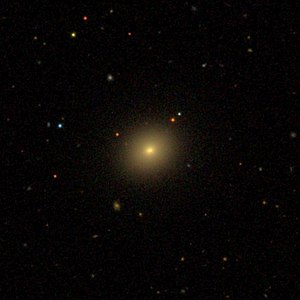NGC 4687
| Galaxy NGC 4687 |
|
|---|---|

|
|
| SDSS | |
| AladinLite | |
| Constellation | Hunting dogs |
|
Position equinox : J2000.0 , epoch : J2000.0 |
|
| Right ascension | 12 h 47 m 23.8 s |
| declination | + 35 ° 21 ′ 07 ″ |
| Appearance | |
| Morphological type | E1 / LINER |
| Brightness (visual) | 13.2 mag |
| Brightness (B-band) | 14.2 mag |
| Angular expansion | 0.7 ′ × 0.6 ′ |
| Position angle | 118 ° |
| Surface brightness | 12.3 mag / arcmin² |
| Physical data | |
| Affiliation | LGG 302 |
| Redshift | 0.014220 ± 0.000077 |
| Radial velocity | 4263 ± 23 km / s |
|
Stroke distance v rad / H 0 |
(192 ± 13) · 10 6 ly (58.8 ± 4.1) Mpc |
| history | |
| discovery | John Herschel |
| Discovery date | March 11, 1831 |
| Catalog names | |
| NGC 4687 • UGC 7958 • PGC 43157 • CGCG 188-021 • MCG + 06-28-031 • KUG 1244 + 356 • 2MASX J12472374 + 3521076 • Mrk 442 • GC 3217 • h 1430 • GALEXASC J124723.70 + 352107.7 | |
NGC 4687 is a 13.2 may bright elliptical galaxy with active galaxies core from the Hubble type E1 in the constellation hunting dogs on the northern sky . It is estimated to be 192 million light years from the Milky Way and about 40,000 light years in diameter.
The galaxies NGC 4711 and IC 3774 are located in the same area of the sky .
The object was discovered by John Herschel on March 11, 1831 .
Web links
- NGC 4686. SIMBAD , accessed February 4, 2015 .
- NGC 4686. DSO Browser, accessed February 4, 2015 .
- Auke Slotegraaf : NGC 4686. Deep Sky Observer's Companion, accessed February 4, 2015 .
